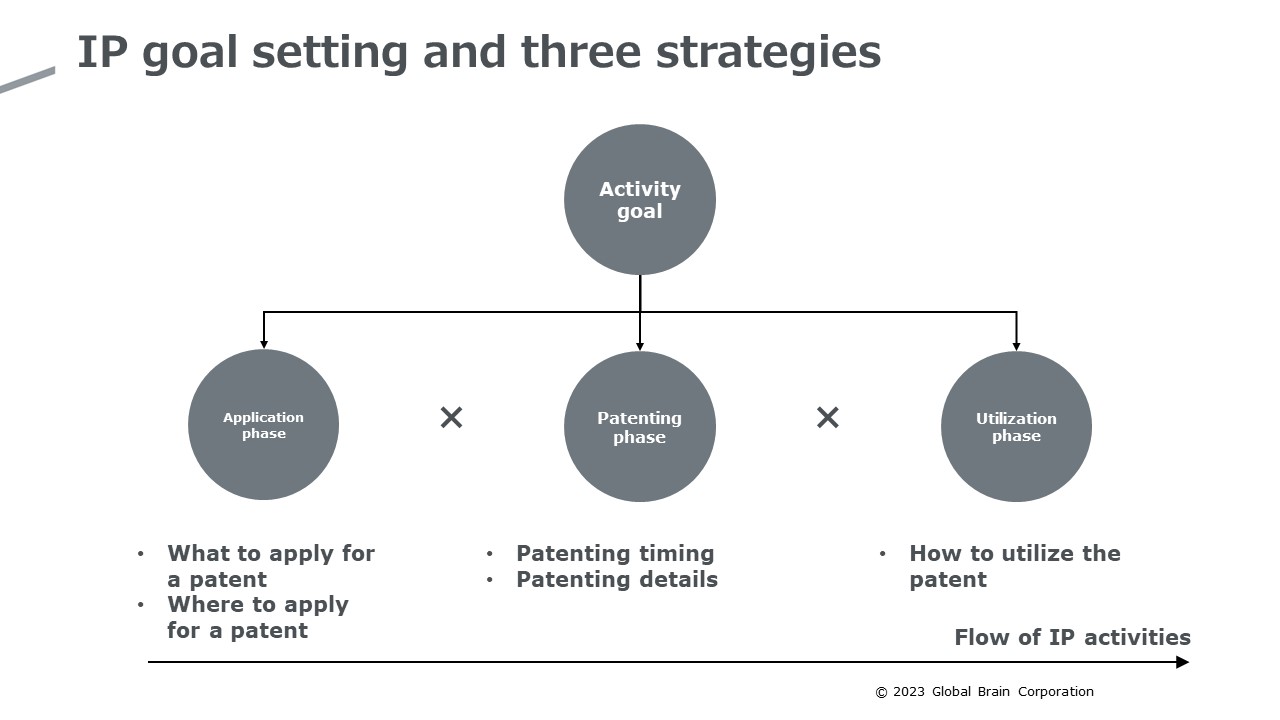Goal Setting and Three Phases for Startups’ Intellectual Property Strategy
This article elucidates how to consider the strategy for intellectual property (IP) activities.

Written by Shohei Hirota
Hello, I am Shohei Hirota, and I support Global Brain’s portfolio companies in pursuing intellectual property (IP) activities. In the previous article, I introduced the approach for considering patent filing. Today, I will explain what an IP strategy is and how to consider it upon starting IP activities.
Basic Idea
The definition of strategy is discussed in many places, but if we see it as “a process or policy to achieve a goal,” the first thing to do when considering an IP strategy is to "set a goal for IP activities.”
IP activities can be broken down into three phases: 1) the application phase where an idea that has emerged in the course of business activities are organized and applied for a patent, 2) the patenting phase where the application is examined and a patent right is granted by the patent office, and 3) the utilization phase where the registered right is utilized.
Therefore, an IP strategy can be summarized as setting a goal for IP activities and considering the measures to take in each phase: the application phase (application strategy), patenting phase (patenting strategy), and utilization phase (utilization strategy).

Setting a goal for IP activities
The purpose of IP activities is, of course, to contribute to the business. However, setting this as a goal is too abstract and makes it difficult to put it into action. To help you come up with more specific goals for your IP activities, here are some goal setting patterns.
Building a Competitive Advantage/Entry Barrier (Moat)
The most basic idea in setting a goal for IP activities is to create a competitive advantage/entry barrier (moat) through IP.
IP is useful and novel information (idea, technology, design, brand, etc.) that can legally prevent imitations, allowing the holder to achieve monopolization. So, establishing a moat would be a basic goal. Even the Tokyo Stock Exchange listing examination considers IP to be one of the sources of competitiveness.
Securing FTO (Freedom To Operate)
Other companies also hold their own IP rights. If you infringe another company’s IP, you may face suspension of business or payment of damages, which may jeopardize your company’s FTO (Freedom To Operate).
Accordingly, when entering a market where there is a large company with a lot of existing IP rights, the initial goal is to secure the company’s FTO before building entry barriers with IP.
Facilitating Alliances
Some business models aim for significant growth through alliances. Deep tech startups especially need to negotiate various agreements with partner companies and drive alliances.
One of the goals of IP activities can be to facilitate alliances by taking advantage of your company’s IP to win favorable agreement terms and make it difficult for partner companies to develop their own products or switch to other companies.
In this way, the first step in building an IP strategy is to set a goal according to your company’s business, taking into account what you want to achieve with IP and what kind of situations you want to avoid.
Not all patterns are mentioned here, but it is important to set a goal that is best for your company’s business based on an understanding of how IP works.
Application Strategy
Once the above goal is set, the next step is to determine the filing strategy. If the goal is to build a moat, you would be considering what kind of rights you would like to have that may function as entry barriers.
While it may be unnecessary to file for some minor aspects that would not be effective as entry barriers, some might be more advantageous to keep it as a secret know-how rather than filing an IP right.
As we have seen here, the application strategy is to specify which functions and technologies you want to apply for patents and which ones you want to keep as a secret. Past articles might help you to consider the strategy.
References:
Are Intellectual Property/Patents Really Necessary for Startups?
https://universe.globalbrains.com/posts/do-startups-really-need-ip-and-patents
Three Perspectives for Startups to Adopt When Considering Patent Filing
https://universe.globalbrains.com/posts/three-perspectives-for-startups-to-consider-for-patent-applications
In addition, if you are planning to expand your business overseas, you need to consider the country where you will be patented. Unfortunately, concerning IP rights such as patents, obtaining a patent in Japan does not give you the same rights in other countries. They are effective only in the country where the rights were granted. Furthermore, after a certain period of time (12 to 30 months depending on how the system is used) has passed from when the application was made in Japan, you will not be able to apply for patent rights in other countries.
Therefore, you need to consider in advance the cost-effectiveness and in which country you should obtain the rights for future overseas expansion of your business.
Patenting Strategy
You may feel a certain sense of accomplishment after overcoming the unfamiliarity of dealing with a patent attorney and completing the application. However, there are points to consider even after the application.
Procedures for obtaining a patent right require a process called request for examination before the examination starts. Also, the crucial point is to control the examination timing and patent right details/scope to be obtained as the details can be modified during the post-examination procedure.
For example, if you are still in the process of hypothesis testing of a product and trying to achieve PMF by seeing how customers react, you probably do not have a firm idea of the product’s functionality and therefore are unable to determine the scope of the patent. Proceeding with the patent examination in haste in such a stage may result in a patent right that is not beneficial to your business because of the gap between the features that won customers and the scope of the patent right.
Since a patent application must basically be filed before the product launch, after filing the application, it is also vital to wait for the examination until the PMF is in sight.
On the other hand, if an application is filed but the examination is not completed, the patent will not take effect. If certain hypothesis testing is completed and the usefulness of the target function or technology is demonstrated, it is essential to proceed with the examination as soon as possible.
Utilization Strategy
The utilization strategy of the patented rights is essentially the reverse process of the goal setting, and the more important part is to put it into concrete actions.
If IP that could be a moat is obtained, it may be used to deter latecomers from entering the market by actively publicizing the IP, or it may be used to back up the company’s corporate value by including it in IR.
If it is to facilitate alliances, it is necessary to consider how to utilize the IP when introducing the company to partner companies, licensing conditions for partner companies, etc. By putting into concrete actions, the strategy for utilizing IP will become much clearer.
Conclusion
So far, we have looked at how to consider the IP strategy. You do not need to think of a sophisticated strategy from the beginning. It is something that needs to be reviewed according to business stages, and it is important to discuss it with IP specialists on a regular basis.
For a company with multiple business lines, the strategy should be considered for each line. Accordingly, it may be necessary to recruit an internal IP specialist once the company reaches a certain size.

Shohei Hirota
Investment Group
Director
Patent & Trademark Attorney
Shohei joined GB in 2020. He launched the intellectual property (IP) team and is responsible for IP-related due diligence and support for portfolio startups.